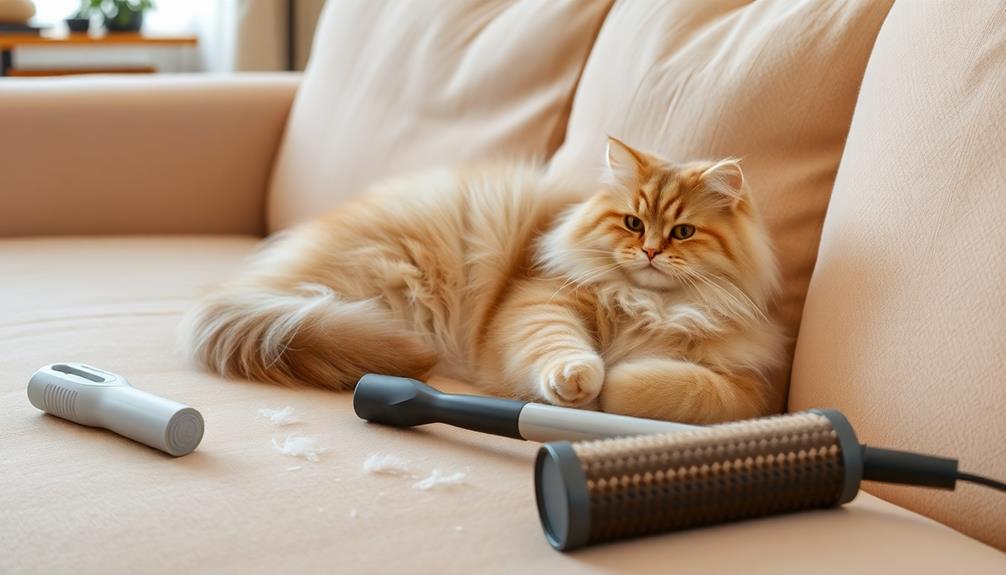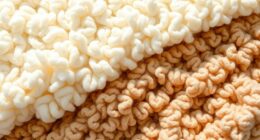To get rid of cat hair on your furniture, start with practical techniques. Utilize a lint roller for quick touch-ups or experiment with damp rubber gloves to easily attract hair. Sticky tape can also be effective; simply apply it to the fabric and then peel it off. Regularly vacuuming with a pet hair attachment can help keep hair under control. Think about using washable throws to cover your furniture and capture hair, making cleaning simpler. Additionally, grooming your cat regularly can decrease shedding. Stay tuned for more tips and tricks to enhance the efficiency of your cleaning routine.
Key Takeaways
- Use a lint roller for quick and efficient removal of cat hair from large surfaces like sofas and chairs.
- Dampened rubber gloves can attract hair through static electricity; simply brush them along the fabric to collect hair.
- Regularly vacuum with a pet hair attachment to thoroughly eliminate cat hair from furniture and carpets.
- Designate specific pet-free zones in your home to limit the areas where cat hair can accumulate.
- Maintain a consistent grooming schedule for your cat to reduce shedding and minimize hair on furniture.
Effective Pet Hair Removal Techniques
When it comes to tackling cat hair on your furniture, you've got several effective techniques at your disposal.
First, consider using a lint roller. It's perfect for quickly removing pet hair from larger surfaces like sofas and upholstered furniture. Just roll it over the area, and watch the hair stick to the sheets. Additionally, maintaining your pet's health through proper care and a balanced diet can help reduce shedding, leading to less hair on your furniture. For more guidance on pet care, check out ultimate hamster care guide.
Another handy tool is dampened rubber gloves. Simply put them on and run your hands over the furniture. The gloves disrupt the static charge that causes hair to cling, making it easy to collect the pet hair.
If you want to loosen stubborn hair, try a fabric softener mixture. Lightly spray it on your upholstered furniture, and it'll help the hair come off more easily when you wipe it down with a cloth or sponge.
For a more unconventional approach, sticky tape or pumice stones can also do the trick. Just press them onto the surface, and they'll gather hair with minimal effort.
With these effective techniques, you can keep your furniture looking clean and free of cat hair.
Preventing Hair Accumulation on Furniture
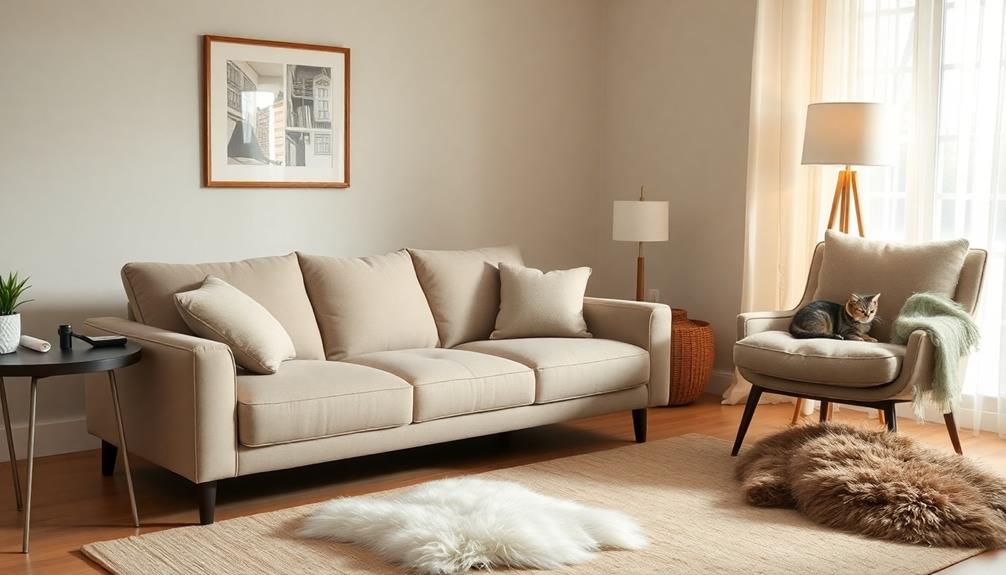
To keep cat hair from piling up on your furniture, implementing a few simple strategies can make a big difference.
Start by designating pet-free zones in your home. By keeping certain areas off-limits to your cat, you can greatly reduce the amount of cat hair that settles on your sofas and chairs.
Additionally, consider using a high-quality vacuum designed for dust removal, as these models are adept at tackling pet hair and allergens, making your cleaning routine more efficient best vacuums for dust removal.
Regular grooming is another essential step. Aim to brush your cat at least twice a week to decrease shedding, which directly impacts the amount of hair that ends up on your furniture.
Additionally, investing in pet-specific furniture, like a cozy cat bed, encourages your feline to stay off your main seating areas, limiting hair accumulation on those surfaces. Additionally, training your pets on where they are allowed can maintain the cleanliness of your home. For example, keeping dogs off furniture by offering them their own designated space, such as a plush dog bed, can greatly reduce fur and dirt on couches and chairs. By creating specific areas for both cats and dogs, you’re not only minimizing mess but also ensuring your pets feel comfortable and at home.
Don't forget about covers and throws! These can effectively protect your furniture from accumulating cat hair and are easier to wash regularly.
Finally, remember to wash your pet's bedding frequently to control the spread of cat hair throughout your home.
Best Sofa Materials for Pet Owners
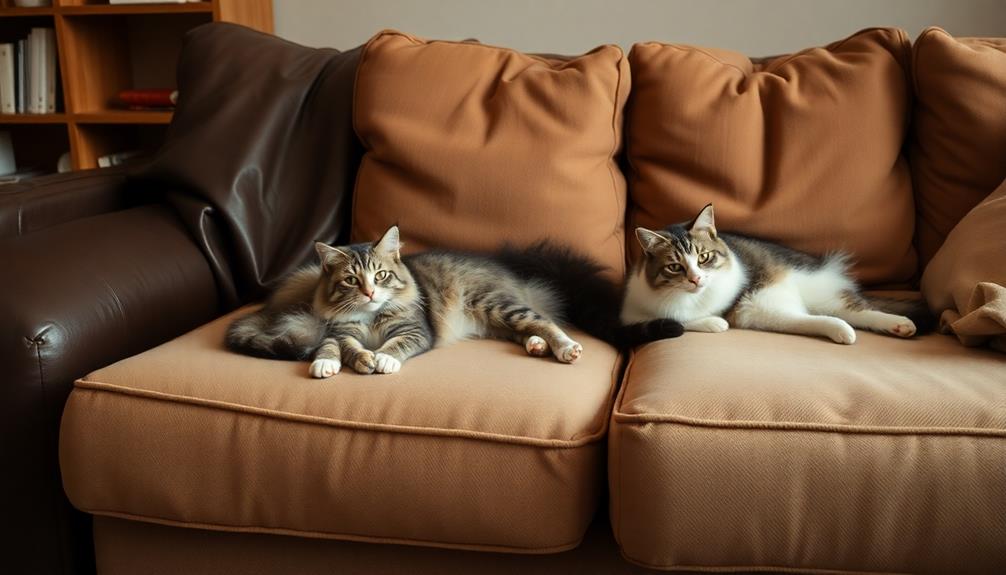
Choosing the right sofa material can make a significant difference for pet owners dealing with cat hair. When selecting a sofa, consider options that are both stylish and practical, especially given that maintaining cleanliness can be a challenge in homes with pets.
Here are some of the best materials for your needs:
- Leather sofa: Resists fur accumulation and is easy to clean, allowing for quick maintenance.
- Woven fabrics: Durable and easy to clean, perfect for homes with pets that shed frequently.
- Synthetic materials: Materials like nylon are pet-friendly and low-maintenance, minimizing pet hair issues.
- Low-pile fabrics: These trap fewer odors and are less prone to scratching, reducing the likelihood of fur embedding into the material.
Plus, regular maintenance can extend the life of your furniture.
– Care kits for leather: Surface scratches can be treated, ensuring your furniture remains in good condition despite pet usage. In addition to handling scratches, these kits often contain products designed to remove stain from leather sofa surfaces, helping to keep your furniture looking pristine. Regular maintenance with a care kit can prolong the life of your leather, ensuring it remains soft and durable over time. With consistent care, even high-traffic areas used by pets can be restored and protected effectively.
Innovative Hacks for Hair Removal
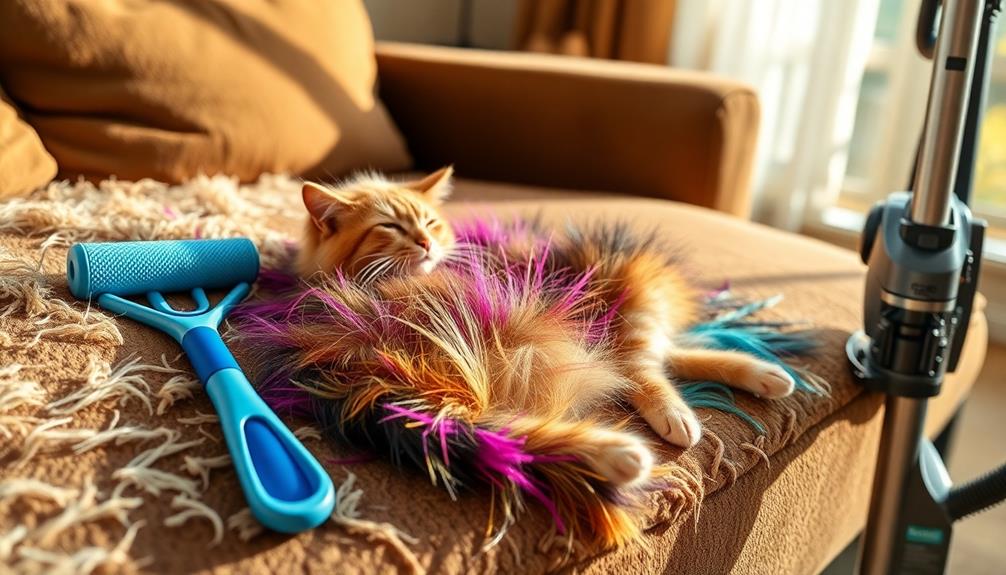
Cat hair can seem relentless, but innovative hacks make removal easier than ever. One of the quickest methods is to use sticky tape. Just wrap it around your hand, sticky side out, and press it against your furniture to lift cat hair instantly.
For a more versatile tool, damp sponges attract pet hair without soaking your fabric, making them ideal for various surfaces. Pumice stones are another excellent option; they gather cat fur with minimal pressure, gently removing hair without damaging your furniture.
If you've got some old sports socks lying around, dampen one and use it to pick up hair. The texture of the fabric works wonders for gathering fur. Rubber squeegees are particularly effective as well. Their static charge helps attract and lift hair from upholstered furniture effortlessly.
For those who prefer a more traditional approach, a lint brush or grooming glove can also work well to remove pet hair.
With these innovative hacks at your disposal, keeping your furniture hair-free becomes a breeze!
Maintenance Tips for Pet Owners
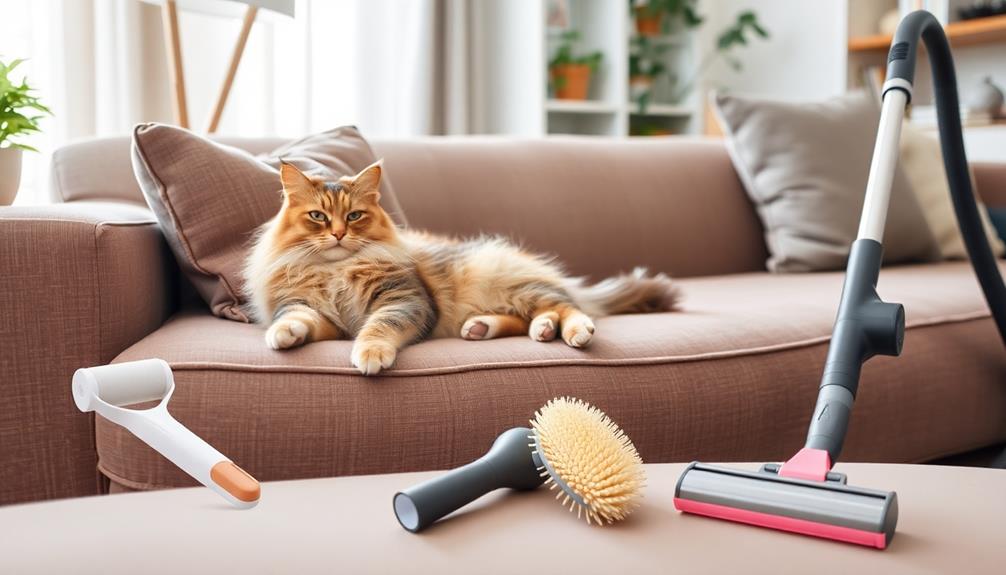
To keep your furniture fur-free, establish a regular cleaning schedule that includes daily vacuuming.
You'll find that using effective cleaning tools, like pet hair rollers and specialized vacuum attachments, makes a big difference.
Staying on top of this routine not only helps maintain your space but also extends the life of your furniture.
Regular Cleaning Schedule
Establishing a regular cleaning schedule can greatly reduce the amount of cat hair on your furniture and create a more comfortable living space.
A consistent cleaning routine helps prevent pet hair from building up, making the process manageable. Here are some tips to keep your home hair-free:
- Daily Quick Clean: Use lint rollers or a damp cloth to pick up hair from surfaces and upholstery.
- Weekly Vacuuming: Commit to vacuuming at least once a week to effectively remove loose hair, dander, and odors from your furniture.
- Clean Pet Bedding: Wash your pet's bedding regularly to minimize shedding and reduce the spread of hair throughout your home.
- Monitor Health: Keep an eye on your pet's health; excessive shedding could indicate underlying issues that need attention.
- Set Reminders: Use a calendar or phone reminders to help you stick to your cleaning routine.
Effective Cleaning Tools
Maintaining a pet hair-free environment not only relies on a consistent cleaning schedule but also on using the right tools for the job. Start with regular vacuuming, using an upholstery brush attachment to effectively remove pet hair, dander, and odors from your furniture.
To enhance your upkeep routine, invest in specialized cleaning tools like oversized sticky rollers and reusable furniture brushes—they're fantastic for capturing pet hair between vacuumings.
If you're looking for cost-effective alternatives, grab a pair of rubber gloves. Simply dampen them slightly, and run your hands over the surfaces to gather pet hair effortlessly. You can also use slightly damp sponges for the same effect.
Before washing textiles like slipcovers and throw pillows, pre-clean them with sticky rollers or brushes to prevent excess hair in your laundry, keeping your washing machine cleaner.
Lastly, don't forget to establish a routine for grooming your pets. Regular brushing not only reduces shedding but also helps keep your home cleaner by minimizing the amount of pet hair that ends up on your furniture.
With the right tools and routine, you can easily maintain a clean living space.
Cleaning Cat Hair From Furniture

Cleaning cat hair from furniture can feel like an endless battle, but with the right techniques, you can make it manageable.
Start by gathering some handy tools to tackle those stubborn hairs effectively. Here are a few methods you can use:
- Damp Rubber Gloves: Wear gloves to remove pet hair; brush your hand along the fabric. The static electricity will help attract the hair.
- Lint Roller: Use a lint roller for quick cleanups on larger surfaces. It's an efficient and disposable option that makes your life easier.
- Fabric Softener Spray: Mix water with fabric softener in a spray bottle and lightly mist your upholstery. This loosens cat hair, making it simpler to wipe off.
- Soft Cloth with Polish: Regularly use a soft cloth with furniture polish or anti-static spray on wooden furniture. This keeps it free from pet hair while enhancing its shine.
- Pre-Clean with Sticky Roller: Before washing fabrics, pre-clean with a sticky roller or brush to prevent excess cat hair from clogging your washing machine.
Understanding Your Sofa Type
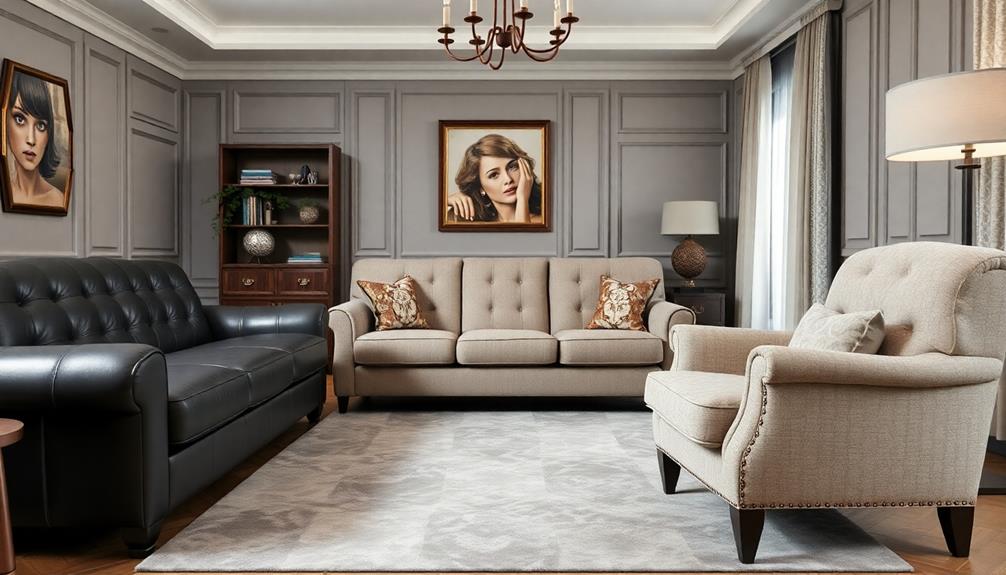
Knowing how to remove cat hair from your furniture goes hand in hand with understanding your sofa type. Each sofa has a care tag located on the underside of the seat, which displays a cleaning code. This code is essential for choosing the right cleaning method without damaging your sofa's fabric. For example, a “W” code indicates that water-based cleaning solutions are safe to use, while an “S” code means you should opt for solvent-based cleaners. By checking the care tag, you’ll have the necessary information to clean upholstery sofa effectively and avoid discoloration or fabric damage. Always test any product on a small, hidden area first to ensure it works well with your specific fabric type.
Here's a quick reference table to help you understand these codes better:
| Cleaning Code | Description | Recommended Action |
|---|---|---|
| W | Wet cleaning | Use water-based cleaners |
| S | Dry solvent | Use solvent-based cleaners |
| SW | Wet or dry cleaning | Use either method |
| X | Professional cleaning only | Vacuum or hire a professional |
Frequently Asked Questions
How Do You Get Cat Hair off a Couch?
To get cat hair off your couch, use dampened rubber gloves to gather fur, or grab a lint roller for quick cleanups. Regular grooming of your cat will also help reduce shedding on your furniture.
How Do You Get Embedded Cat Hair Out of Fabric?
Like a magician pulling a rabbit from a hat, you can tackle embedded cat hair. Just dampen rubber gloves or use a pumice stone; both will work wonders to lift stubborn strands from fabric effortlessly.
How to Remove Cat Hair From Everything?
To remove cat hair from everything, use damp rubber gloves, sticky tape, or a pumice stone. Regularly groom your cat and consider a specialized pet vacuum for efficient, thorough cleaning around your home.
Do Dryer Sheets Remove Pet Hair?
Imagine a soft, fragrant breeze sweeping through your home. Yes, dryer sheets can effectively remove pet hair. Just rub one over your furniture, and watch as it attracts and lifts stubborn fur, making cleanup effortless.
Conclusion
In the epic battle against cat hair, you've armed yourself with the ultimate strategies. With these tips, your furniture can shine like a hairless wonder, free from the feline fluff that once ruled your space. Remember, preventing hair buildup is just as vital as the clean-up. So, gear up, stay vigilant, and transform your home into a cat-hair-free fortress. After all, you deserve to lounge in comfort without battling a fur-covered couch every single day!
